|
|
|
 Joel's Blog Joel's Blog |
 Built-It Blog Built-It Blog |
 Video Roundup Video Roundup |
 Classes & Events Classes & Events |
 Work Magazine Work Magazine |
|
Hours: M-F 9:00-5:00, closed Sat,Sun Our Guarantee & Return Policy Shipping and Sales Tax Info Privacy Policy Holiday Calendar |
|
Contact Us:
Email: support@toolsforworkingwood.com Phone: 800-426-4613 or 718-499-5877 Visit Us in Brooklyn: Directions to Our Showroom © 1999-2019 toolsforworkingwood.com Powered by 01 Inc. Coded entirely in NYC |



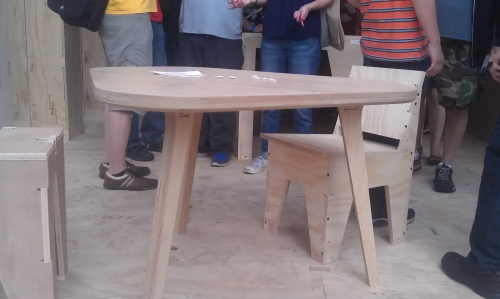 In my final post about
In my final post about 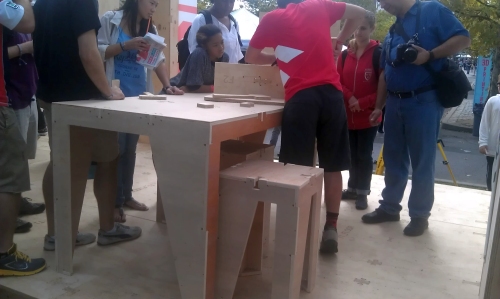 But in the search for streamlined, push button manufacture the Maker Faire folks forgot something important. From a making standpoint being able to push a button and have a machine spit out snap together parts is very very cool. But from an end user standpoint what is important is design, quality, and cost. Using a CNC router as just one tool in the arsenal of many. In the hands of a skilled crafts-person CNC can really open up your design options. But trying to make a CNC router the be all and end all limits your options and wastes material. It's cool to be able to CNC a mortise and tenon, but it wastes material for the tenon and the joint is nowhere as strong as a
But in the search for streamlined, push button manufacture the Maker Faire folks forgot something important. From a making standpoint being able to push a button and have a machine spit out snap together parts is very very cool. But from an end user standpoint what is important is design, quality, and cost. Using a CNC router as just one tool in the arsenal of many. In the hands of a skilled crafts-person CNC can really open up your design options. But trying to make a CNC router the be all and end all limits your options and wastes material. It's cool to be able to CNC a mortise and tenon, but it wastes material for the tenon and the joint is nowhere as strong as a 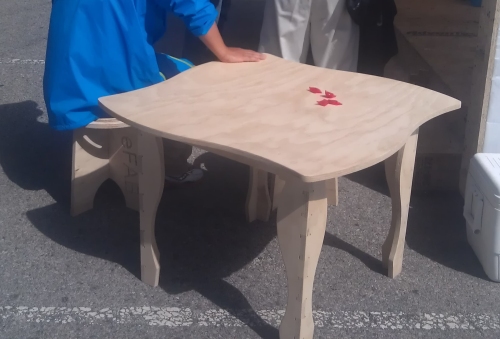 It's a cool technical challenge to design anything while limiting yourself to only one material and one method of fabrication. And for that the Maker Faire folks deserve credit. But as the harbinger of the future I am not holding my breath. What I am waiting for is for traditional cabinetmakers to evolve the ideas I saw at Maker Faire into something I want in my house.
It's a cool technical challenge to design anything while limiting yourself to only one material and one method of fabrication. And for that the Maker Faire folks deserve credit. But as the harbinger of the future I am not holding my breath. What I am waiting for is for traditional cabinetmakers to evolve the ideas I saw at Maker Faire into something I want in my house. 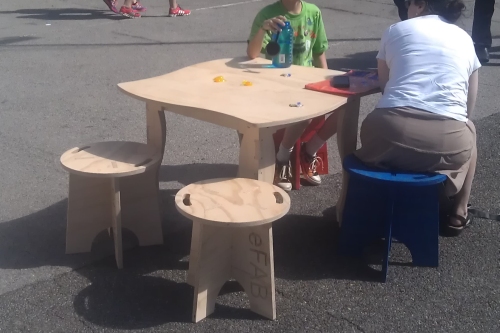
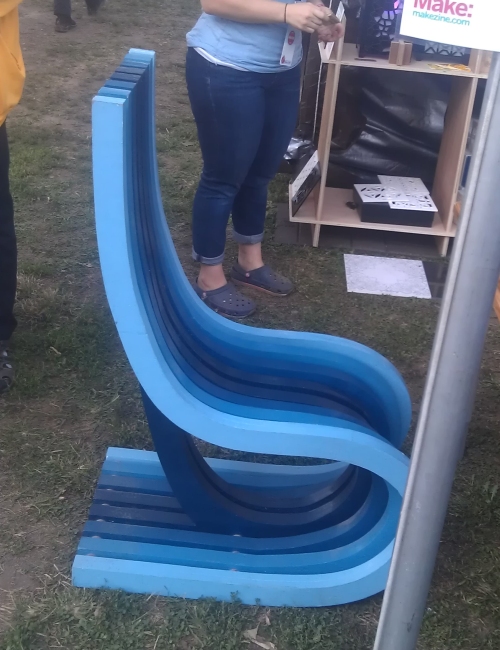
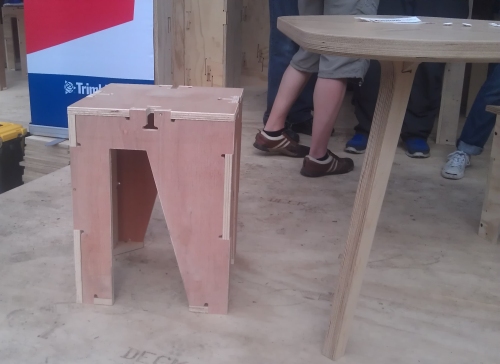
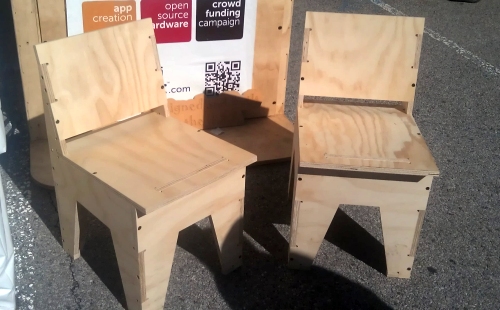
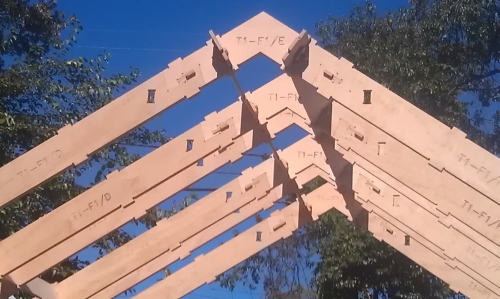
The exciting part of computer and cnc technology for me is two fold. Firstly, I'm excited about what will happen once the current aesthetic of panel construction and visible joinery becomes as cliched as another piece of factory furniture from target. Soon designers will have to find new ways to push more from the technology, creating pieces that don't 'look' cnc'd. Secondly, I think more people will start to find successful ways to combine cnc work with traditional craft, elevating the standards of both. It's just another tool in the quiver, not a replacement for everything that came before it!
I think the ability of the machine to produce finished work has the danger of creating a new generation of makers whose aesthetic options are sorely limited by their lack of a broader palate of tools for creating work.
This being said, there are some advantages. I think visible joinery has a way inviting the casual observer to think more about process and construction. Looking at 'production' chair from Wal-Mart, one sees only a chair. These plywood/bamboo/cnc'd pieces reveal their design and construction at first glance. Many are intended to be assembled by the end user like a 3D puzzle. Maybe this will engender a more democratic and widespread appreciation for the design and fabrication that goes into any designed object?
I think as along as modern makers don't forget the thousands of years of lessons that can be learned from the traditional makers of the past, the future holds a great deal of excitement and possibility as new design and build capabilities merge with the old and further the reach of the imagination.
Time to add a shameless plug and encourage people to view my website. The large modular bench as well as the lighted wall cabinets are made using a healthy dose of both traditional and digital methods. The forms and curves therein would have been extremely difficult to create using traditional methods alone. But there was still plenty of opportunity for the bandsaw, handsaw, cabinet scraper and rasp to do their bidding.
And I have no problem with that! The fact that Michael Graves uses a Chinese factory to bring his designs to the masses is, I think, a good thing. And people with CNC machines can bring style to a lot of people who couldn't afford it before (at least, as this technology gets better over time).
But these things should not be confused with handmade goods--what I would define as goods where the hand of the maker is evident in each piece. Goods where tools are used that will inherently result in each piece being different, and the maker is not only OK with that but likes that. I think that people can intuitively tell the difference between these two kinds of things without even a close examination, but those who can't should definitely buy the items that are not 'truly' handmade. And none of us can afford to buy all artistically handmade items; we have to pick and choose. And I would much rather buy a CNC'd item at a reasonable price that shows the designer's creativity, if not the maker's hand. But I think it is important for those of us who can tell the difference to stand up and say that we believe there is a difference (and believe there will always be a difference no matter how good CNC machining gets).
I also note that most of the items in your photographs do not appear to be finished. It is my experience that people who are most interested in CNC machining are not so much interested in creating a great piece of work, rather they are interested in the gee-whiz aspect of using the latest gadget. And it can create some incredible pieces. But a great wooden object requires a great finish. How good these objects are in the end will depend on the extent to which these makers care enough to put in the time for a great finish on a CNCed item.
Just some thoughts...Peter
By their own credo, maker faire is supposed to be "forward-looking, showcasing makers who are exploring new forms and new technologies". I don't really see that here. Unlike 3D printing which actually is democratizing and customizing plastic manufacturing, this is more of the same old process.
An argument could be made that the designers are not actually designers by trade but just hobbyists who are self taught google sketchup artists. Fair(e) enough, but is that innovation?
This is to furniture what TV dinners are to cuisine.
It's a cunning simulation, at best.
As an industrial designer by education, a draftsman/cnc programmer/designer by trade, and a hand tool woodworker at heart (on the weekends!) I struggle with this very issue.
Seeing the possibilities in machining 12/18/27mm Russian Birch MultiPly in innovative shapes to overcome design problems is exciting at times.
Years ago when I first started on CNC programming - 1988! - I tended to be drawn in to the technology and fetish-ize the capabilities and apply it every every project I could think of. This lasted a while, it is fun!
Now I draw great satisfaction from forgoing the cnc solution, and choosing instead to work each piece by hand - eve in multiple piece small runs. I want to grow and nurture the inner craftsman/designer inside me rather than indulge the inner designer at the expense of the craftsman.
Balance grasshopper, balance.
Thanks for the photos Joel!